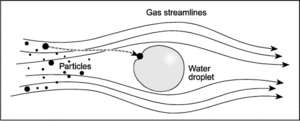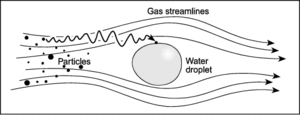Deposition (aerosol physics) facts for kids
Imagine tiny bits floating in the air, like dust or smoke. These tiny bits are called aerosols. Deposition is when these aerosols land and stick to solid surfaces. This process helps clean the air by removing the particles from it.
There are two main ways this happens: dry deposition and wet deposition. How fast particles settle is called 'deposition velocity'. It's slowest for particles that are medium-sized. Very large particles fall quickly because of gravity, while very small particles are influenced by something called Brownian motion (random jiggling). Tiny particles often stick together over a few hours until they reach a certain size. This process is important for understanding how much PM-2.5 (tiny air pollution particles) is in the air.
Deposition velocity helps us understand how quickly particles move from the air to a surface. It's like how fast a leaf falls to the ground.
Sometimes, we want to know if a particle will hit an obstacle, like a tree branch. We can predict this using something called the Stokes number. If this number is small (less than 1), the particle will likely go around the obstacle. If it's large (more than 1), it will probably hit it.
How Particles Settle: Dry Deposition
Dry deposition happens when particles settle out of the air without rain or snow. Here are some ways it occurs:
- Impaction: Imagine a tiny particle moving fast. If it tries to go around a bigger object, like a leaf, it might not be able to turn sharply enough because of its speed. So, it crashes into the object instead. The heavier the particle, the more likely it is to hit.
- Gravitational Settling: This is simply when particles fall to the ground because of gravity, just like a rock falls.
- Interception: Particles might follow the air currents around an object. But if they get too close, they can still brush against and stick to the object, like a tiny bug hitting a spiderweb.
- Turbulence: Air isn't always smooth; it has swirling movements called eddies. These eddies can push particles around, making them collide with surfaces.
- Other ways: Particles can also be moved by differences in temperature (thermophoresis), by being pushed by other moving particles (diffusiophoresis), or by electrical charges (electrophoresis).
How Particles Settle: Wet Deposition
In wet deposition, particles are removed from the air by rain, snow, or other forms of precipitation. It's like the sky washing the air clean! This happens when tiny aerosol particles get caught by water droplets or ice crystals.
- Below-cloud scavenging: This happens when rain or snow is falling through the air. As the droplets or snowflakes fall, they bump into aerosol particles. They can catch these particles through random movement (Brownian diffusion), by hitting them (impaction), or by simply getting close enough (interception).
- In-cloud scavenging: This occurs inside clouds. Aerosol particles can act as tiny seeds for cloud droplets or ice crystals to form around. Once they are part of a cloud droplet, they can be brought down to the ground when it rains or snows.
See also
- Condensation in aerosol dynamics
- Particle collection in wet scrubbers
- Van der Waals force



